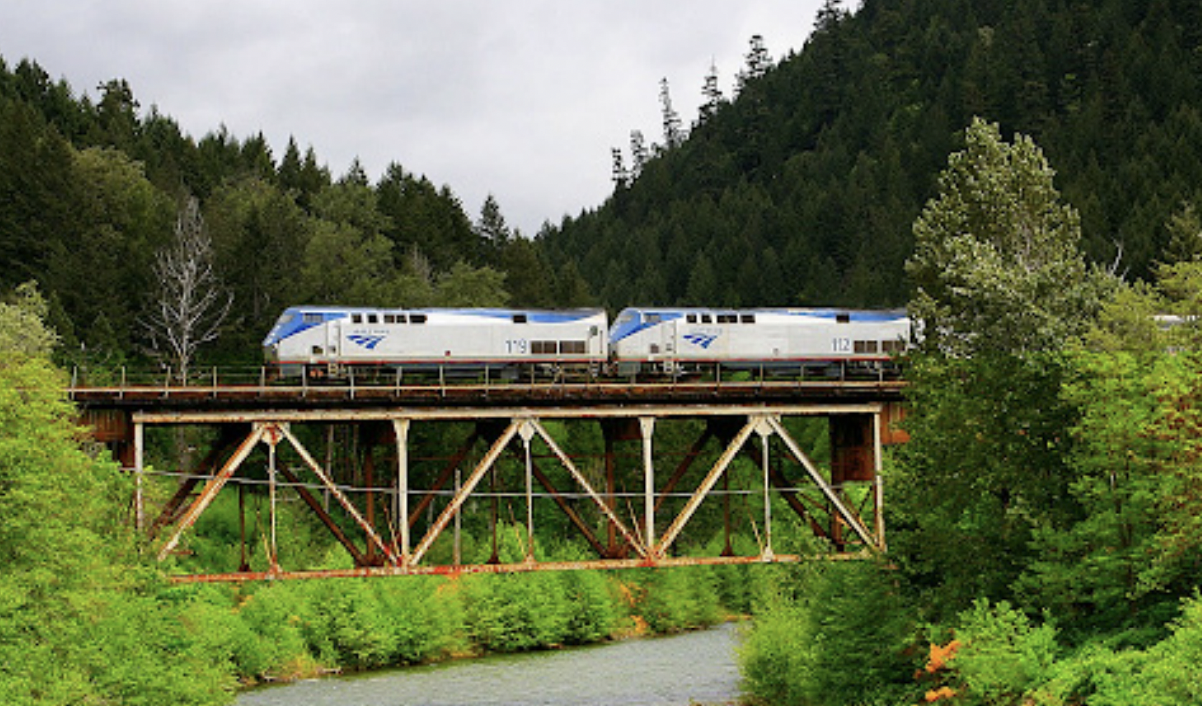
By Alex Meislich
The blur formed by passing pine trees belies our unhurried progress as the train traces Odell Lake’s western bank. Each tree, perhaps only 15 feet from the sweeping windows, displays a jigsawed patchwork of bark tiles for the few seconds that it remains in view. Focusing on the slivers of lake edging through the nettles proves somewhat challenging due to the closeness of the pines and the speed at which they pass. The last time that I was here, winter had come in full force, saturating each tree’s branches with snowfall and painting the landscape white as if to highlight the perennial blue of Odell. Twelve miles further north, when the meandering track doubled back on itself at the start of the route’s only switchback, I had looked eight cars ahead to see the locomotives exiting the curve, powering through snow as we continued our ascent into the heart of Oregon’s Cascades.
As novel as it seems to cross America’s wilderness over land, passenger rail travel in the United States is not new. According to the American Association of Railroads, route mileage peaked at 254,000 in 1916, and the 1970 census reported 47.3 billion passenger miles traveled in 1920 (compared to the meager 10 billion traveled in 1970). So, what happened? The answer is as conclusive as it is short: planes killed trains, and highways did not help much either. The good news is that even though few people seem to use it on a regular basis, rail travel lives on in America and remains a superior option this winter break for south-bound Loggers with a penchant for adventure.
Amtrak’s Coast Starlight route spans the entire western seaboard with stops in prominent cities such as Tacoma, Portland, Oakland, San Jose and Los Angeles. Travelers may choose to spend the duration of their cross-country journey in the lounge car where they can watch vast expanses of undisturbed wilderness rush by as the train carves between mountains. While the virtually nonexistent baggage limits and direct routing to downtown hubs are perfect for the homebound college student, this is where the true appeal of rail travel lies: grounding passengers in the unending landscape throughout the journey. While planes must also pass through physical space, their route is too far removed from the world for them to establish a sense of place. From seven miles above the ground, only the largest features can be identified: trees are green dots, mountains are gray, snow is white, oceans are blue. Furthermore, because planes travel at speeds that most cannot even comprehend, the trip from SeaTac to San Francisco requires only two hours of flight time. People who have only ever flown from the Sound to the Bay might not fully appreciate what an 800-mile journey truly is.
Despite their ability to abbreviate trips that are too long or dangerous to make by other means, planes deprive passengers of something important. To travel should be to experience a journey in its entirety and, while the purist might therefore choose to travel on foot, rail provides a pragmatic alternative for normal people. Compared to planes that act as a black box, teleporting passengers from A to B, trains provide a level of interaction similar to a road trip. After experiencing the hundreds of miles between origin and destination, a rail traveler feels a sense of satisfaction and an appreciation for their city as a place in the world. To a passenger flying, a city discovered is a point in isolation — a destination without a journey — but to a train traveler, it is something part of a larger whole.
Despite their ability to abbreviate trips that are too long or dangerous to make by other means, planes deprive passengers of something important. To travel should be to experience a journey in its entirety and, while the purist might therefore choose to travel on foot, rail provides a pragmatic alternative for normal people. Compared to planes that act as a black box, teleporting passengers from A to B, trains provide a level of interaction similar to a road trip. After experiencing the hundreds of miles between origin and destination, a rail traveler feels a sense of satisfaction and an appreciation for their city as a place in the world. To a passenger flying, a city discovered is a point in isolation — a destination without a journey — but to a train traveler, it is something part of a larger whole.
Of course, there are drawbacks. Some may consider the 22-hour journey from Tacoma to Oakland, or the 34-hour journey to Los Angeles as excessive. After all, the train does not offer WiFi, and large swaths of track circumvent cell coverage, particularly in Southern Oregon. There is also “the overnight problem” — in essence, getting comfortable enough to fall asleep when night comes. A true traveler, however, does not view these obstacles as insurmountable; instead, they bring with them three pillows, two layers of pajamas, several chocolate bars, and a good book. In the morning, such a traveler will wake at sunrise, fully rested and covered in candy wrappers, with the book still open and only a few hundred miles to go.
